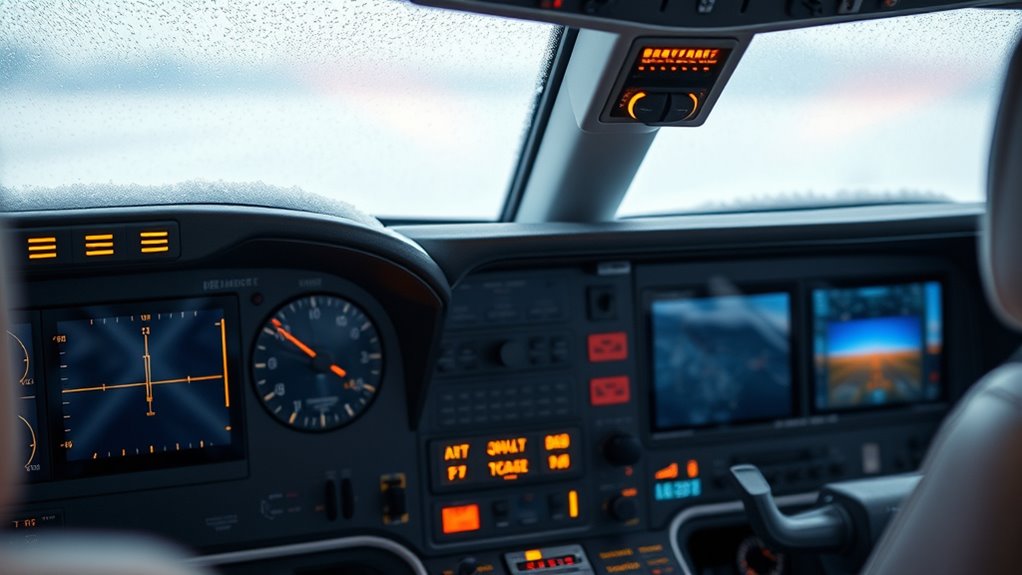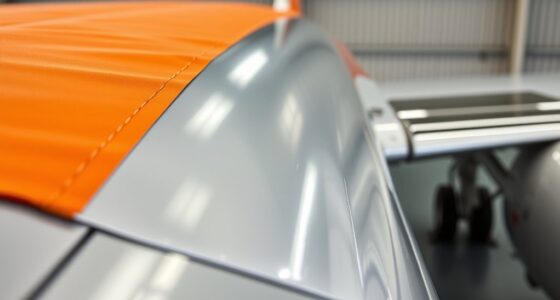For winter cockpit heating, you can choose built-in systems that distribute warm air efficiently, portable electric heaters for quick warmth, propane or fuel heaters for rapid heat, heat exchangers linked to your engine, or an auxiliary power unit to keep the cabin cozy without running the engine. Each option offers different benefits in cost, efficiency, and installation complexity. To find out which suits your needs best and how to maximize your comfort, keep exploring the options available.
Key Takeaways
- Different heating options include built-in systems, portable electric heaters, propane/fuel heaters, engine-driven heat exchanges, and auxiliary power units (APUs).
- Each system varies in cost, efficiency, installation complexity, safety considerations, and pilot comfort.
- Built-in systems provide even warmth and integrate with insulation, while portable heaters offer quick, flexible solutions.
- Engine heat and APUs maximize efficiency but require proper installation, maintenance, and electrical support.
- Effective insulation and sealing enhance heat retention, reducing energy needs across all heating options.
Built-In Aircraft Heating Systems

Have you ever wondered how aircraft stay warm during cold winter flights? Built-in aircraft heating systems play a pivotal role in maintaining a comfortable environment. These systems work with the plane’s cabin insulation to retain heat and prevent cold air from seeping in. As a pilot, your comfort depends on these integrated systems, which are designed to evenly distribute warm air throughout the cockpit. They operate efficiently, ensuring you stay warm without the need for external heaters. Because they’re built into the aircraft, they require less manual intervention and provide consistent heating throughout the flight. This integrated approach not only keeps the cabin cozy but also enhances pilot comfort, allowing you to focus on flying without distraction from the cold. Proper storage and maintenance of these systems can further improve their performance and lifespan.
Portable Electric Heaters

Portable electric heaters offer a flexible solution for maintaining cockpit warmth during winter flights, especially when built-in systems fall short or require supplemental heat. They are easy to install and can quickly boost interior comfort when needed. You simply plug them into an available power source, making them highly convenient for short-term or emergency heating. However, safety considerations are critical; ensure they are placed away from flammable materials and that cords are secure to prevent tripping or electrical issues. These heaters typically produce no emissions, reducing concerns about fumes. While they won’t replace all-encompassing heating systems, portable electric heaters provide a reliable, cost-effective way to keep the cockpit comfortable and safe during cold conditions, especially when quick, supplemental warmth is essential. Understanding safety protocols is vital when using portable electric heaters to prevent potential hazards.
Propane and Fuel-Powered Heaters
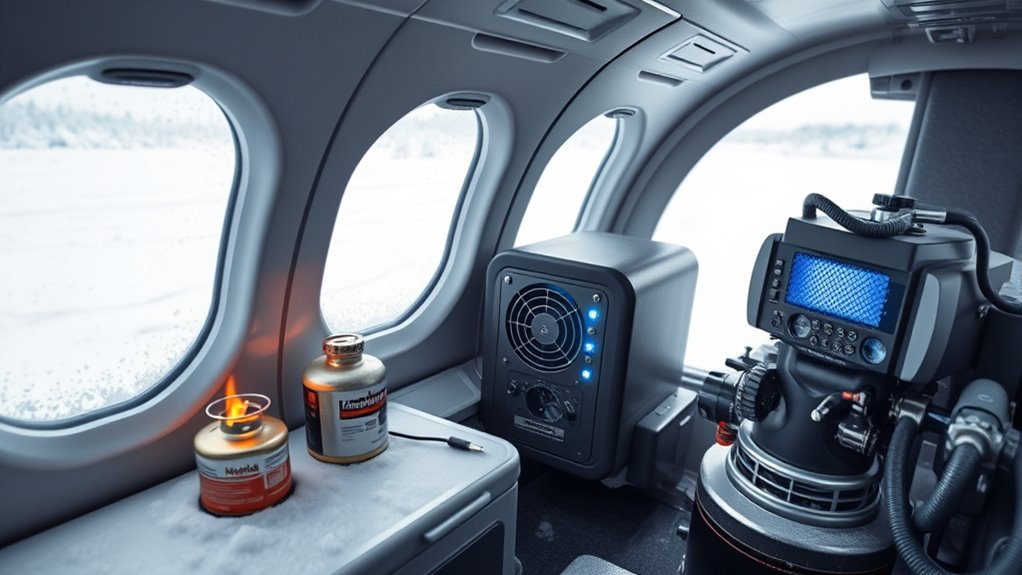
Propane and fuel-powered heaters are effective options for providing reliable warmth in the cockpit, especially during extended winter flights where electrical solutions may fall short. They deliver quick, consistent heat, enhancing your personal comfort when flying in cold conditions. However, safety considerations are critical—these heaters produce fumes and require proper ventilation to prevent carbon monoxide buildup. Always ensure your heater is well-maintained and used according to manufacturer instructions. These systems are portable and can be easily installed, making them versatile for different aircraft types. While they offer reliable warmth, you must be vigilant about fire hazards and proper fuel handling. proper ventilation is essential to ensure safe operation and prevent dangerous fume accumulation. When used correctly, propane and fuel-powered heaters can considerably improve comfort without compromising safety.
Heat Exchanges and Engine-Driven Systems

Engine-driven heat exchange systems can be efficient, but they often use more power and may impact performance. Installation can be complex, requiring careful planning and space considerations. Regular maintenance is essential to keep these systems durable and functioning reliably in cold conditions. Proper system identification helps ensure optimal operation and longevity of the heating setup.
Efficiency and Power Use
Heat exchanges and engine-driven systems are designed to maximize efficiency while minimizing power consumption, making them essential for effective winter cockpit heating. They optimize fuel consumption and enhance power efficiency by using engine heat directly, reducing the need for extra power sources. This approach ensures you get reliable warmth without draining your battery or consuming excessive fuel. Additionally, thermal management techniques play a crucial role in maintaining consistent cabin temperatures. Here’s a quick comparison:
| Feature | Benefit |
|---|---|
| Fuel consumption | Lower, thanks to engine heat use |
| Power efficiency | High, minimal energy waste |
| Warm-up time | Quick, as engine heat is readily available |
| Operating cost | Reduced, less auxiliary power needed |
| Environmental impact | Lower emissions, efficient use of resources |
This setup keeps your cockpit warm while conserving fuel and energy, especially during colder flights.
Installation Complexity
Installing heat exchanges and engine-driven heating systems can be a complex process that requires careful planning and technical knowledge. You’ll need to contemplate the space available, compatibility with your aircraft’s existing systems, and proper integration to guarantee reliable operation. These systems often involve mounting heat exchangers, routing coolant lines, and connecting controls, which can be challenging. Safety considerations are critical; improper installation can lead to leaks, fire hazards, or reduced functionality. Additionally, you must evaluate how the installation impacts interior comfort—poor placement or integration can result in uneven heating. Due to these complexities, professional installation is highly recommended, especially if you want a system that’s both efficient and safe. This ensures ideal performance while maintaining safety standards and maximizing interior comfort during winter flights. Understanding the installation process is essential for ensuring a successful setup.
Maintenance and Durability
Maintaining heat exchange and engine-driven heating systems requires ongoing attention to guarantee they remain reliable and efficient over time. Regular inspections help prevent corrosion and leaks that could compromise interior comfort and exterior protection. Keep heat exchangers clean and check for blockages to ensure maximum heat transfer. Engine-driven systems need periodic servicing to maintain performance, especially in cold conditions, to avoid breakdowns that leave you exposed to the elements. Proper maintenance extends the system’s lifespan, reducing costly repairs and ensuring consistent warmth during winter. By staying proactive, you preserve both the interior comfort your system provides and the exterior protection it offers for your vehicle’s components. Overall, diligent upkeep is key to maximizing durability and guaranteeing your heating system functions smoothly year after year.
Auxiliary Power Unit (APU) Heating
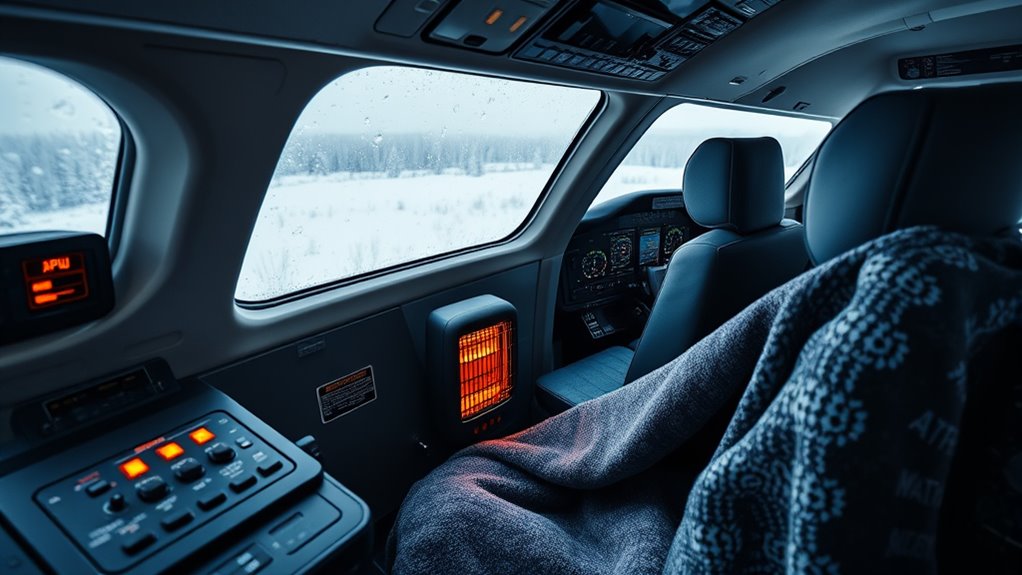
APU heating can be an efficient way to keep your cockpit warm without relying on engine operation, but it’s important to weigh the costs involved. You’ll want to contemplate installation requirements and whether the system is compatible with your aircraft’s setup. Understanding these factors helps you choose the most effective and economical solution for winter comfort. Additionally, considering maintenance and support options can ensure reliable operation during colder months.
Efficiency and Cost
Because auxiliary power units (APUs) are designed to provide heating without relying on the main engines, their efficiency directly impacts operational costs during winter. A more efficient APU reduces fuel consumption, saving you money and ensuring pilot comfort during cold conditions. However, higher efficiency often comes with increased initial costs. Maintenance and fuel expenses also influence overall cost-effectiveness. When considering safety protocols, reliable APUs minimize risks related to engine startup issues. Additionally, choosing an energy-efficient system can contribute to environmental sustainability by reducing carbon emissions. Here’s a quick comparison:
| Feature | Cost | Fuel Efficiency | Pilot Comfort |
|---|---|---|---|
| Standard APU | Moderate | Average | Adequate |
| High-Efficiency APU | Higher initial | Superior | Enhanced |
| Hybrid Systems | Variable | Good | Consistent |
| Electric Heaters | Low upfront | Less efficient | Immediate warmth |
Installation and Compatibility
Selecting the right heating system for your aircraft depends on its existing infrastructure and compatibility with auxiliary power units. APU-based heating systems are generally straightforward to install if your aircraft already supports auxiliary power connections, making integration seamless. Compatibility with your aircraft’s electrical systems ensures reliable interior climate control without adding excessive weight or complexity. When considering installation, check if your aircraft’s electrical capacity can handle the additional load, and confirm the available space for the heating components. Proper installation enhances pilot comfort by providing consistent warmth and reducing cockpit fogging. Ensuring that your aircraft’s electrical system is properly configured for auxiliary power integration can significantly streamline the setup process. Guaranteeing compatibility and a proper setup minimizes downtime and maintenance issues, making auxiliary power unit heating a practical choice for maintaining ideal cockpit conditions in winter.
Insulation and Cabin Draft Prevention
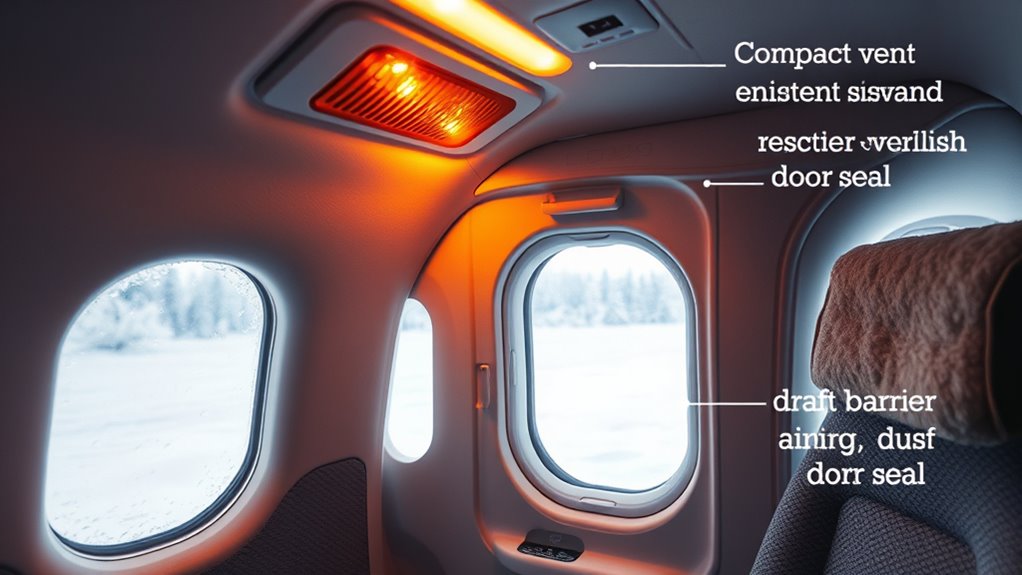
Have you ever wondered how to keep your cockpit warm without wasting energy? The key is effective insulation and draft prevention. Start with seat cushioning; well-padded seats trap heat and add comfort, reducing the need for extra heating. Next, focus on window insulation—adding thermal curtains or insulating film helps block cold drafts and retain heat inside the cockpit. Sealing gaps around vents and windows prevents cold air from seeping in, ensuring the warmth stays where you need it. These simple steps improve overall insulation, making your cockpit warmer and more energy-efficient. Proper insulation doesn’t just keep you comfortable; it also reduces fuel consumption by decreasing your reliance on additional heating sources. Implementing these measures makes winter flying safer and more pleasant, and regularly assessing and adjusting space organization can further optimize your cockpit environment for comfort.
Frequently Asked Questions
How Do Heating Options Impact Aircraft Weight and Fuel Efficiency?
Heating options impact aircraft weight and fuel efficiency by adding weight and increasing fuel consumption. You’ll carry extra systems or fuel for heating, which raises weight implications. This extra weight means your aircraft needs more fuel to maintain performance, reducing overall fuel efficiency. So, choosing efficient heating solutions helps balance comfort with operational costs, ensuring you don’t compromise too much on fuel economy during winter flights.
Are There Safety Concerns With Using Portable Heaters in Aircraft Cabins?
You should be aware that portable heater safety is vital because improper use can create aircraft cabin hazards. Using portable heaters may lead to fire risks, carbon monoxide buildup, or electrical issues if not designed for aviation. Always guarantee that the portable heater meets aviation safety standards, and follow proper protocols to mitigate aircraft cabin hazards. Proper safety measures protect everyone onboard and prevent accidents related to portable heaters.
Can These Heating Systems Be Operated Remotely or Automatically?
Imagine the convenience of controlling your aircraft’s heating system without leaving your seat. You wonder if these systems can be operated remotely or automatically. The answer is yes—many modern systems feature remote control options and automatic operation, ensuring safety and comfort. However, always verify that these features meet safety standards and are properly maintained, so you can enjoy warmth and peace of mind during your flight.
What Maintenance Is Required for Different Cockpit Heating Methods?
You need to regularly check and replace heater filters to guarantee efficient heating and prevent clogs. For electrical system checks, inspect wiring and connections to avoid issues like shorts or failures. If your system has a manual or automatic feature, keep these components clean and functioning properly. Routine maintenance helps extend the lifespan of your cockpit heater, keeps it running smoothly, and ensures consistent warmth during winter flights.
How Do Heating Options Vary for Different Aircraft Sizes and Models?
Imagine a cozy cabin glowing warmly amidst a winter landscape—your aircraft’s heating varies like that glow, depending on its size and model. Larger aircraft often rely on centralized systems, while smaller ones may use portable or electric heaters. Model differences influence the complexity and efficiency of these systems, ensuring each cockpit stays comfortable. You adapt your heating choice to match your aircraft’s size, making winter flights safe and warm.
Conclusion
Choosing the right winter cockpit heating option is like selecting the perfect winter coat—you want warmth without weight or hassle. I once froze during a cold morning flight until I switched to an engine-driven system, and suddenly, the cabin was cozy as a fireside. Remember, each method has its strengths; your comfort depends on your aircraft and flying style. With the right setup, you’ll stay warm and focused, no matter how frosty the skies get.
With a heart that soars as high as the skies, Aria, affectionately known as “Skylark,” is the driving force behind Soaring Skyways. Her journey into the gliding world began as a young dreamer gazing up at the soaring birds, yearning to experience the weightlessness and freedom they embodied. With years of experience both in the cockpit and behind the scenes, Aria’s commitment to the gliding community is unwavering.
